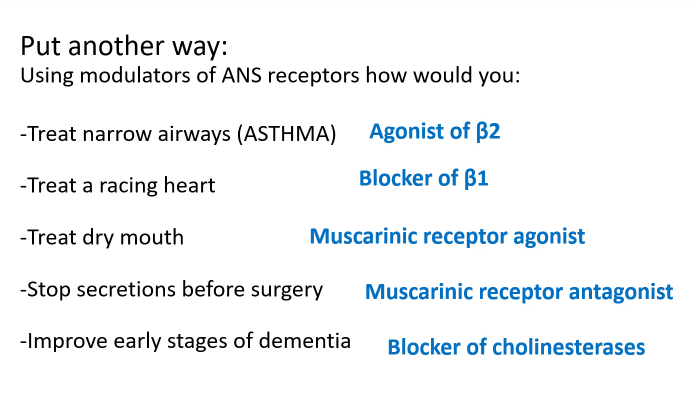-
Which Receptors Control the Adrenoceptor-Mediated Responses? And State those Responses (Sympathetic)
a1-Arterial narrowing, seminal vesical constriction. Radial muscle contraction leading to wide pupils
a2-Reduction of transmitter release from sympathetic nerves
b1-Increased heart rate and force of contraction
b2-Airway and artery relaxation. Bladder and uterus relaxation
b3-Sugar metabolism. Bladder and uterus relaxation
-
Which Receptors Control the Muscarinic cholinoceptor-Mediated Responses? And State those Responses (Parasympathetic)
m1-Gut acid production, sweat production
m2-Decreases cardiac activity
m3-Saliva and sweat production, release of NO from endothelium, contraction of visceral smooth muscles, pupil narrowing
m4-CNS
m5-CNS
-
What is an agonist?
An agonist is a substance that mimics the actions of a neurotransmitter or hormone to produce a response when it binds to a specific receptor in the brain
-
What is an antagonist?
A chemical substance that binds to and blocks the activation of certain receptors on cells, preventing a biological response
-
What is Benign prostatic hyperplasia?
A condition in men in which the prostate gland is enlarged and not cancerous
-
Symptoms of benign prostatic hyperplasia? (6)
-weak, slow urinary stream
-a hesitancy and straining to urinate
-prolonged voiding,
-an inability to empty the bladder completely
-an urgent, sometimes uncontrollable need to void,
-nighttime urination (nocturia)
-
What does blocking a1-adrenergic receptor do in terms of benign prostatic hyperplasia?
a1-Arterial narrowing
Blocking it causes relaxation of smooth muscle in the bladder, neck, urethra and prostate gland
-
Are there any uses for agonists and antagonists for the a2 adrenergic receptor? And what drugs act as them?
a2-Reduction of transmitter release from sympathetic nerves
No real use for agonist, although CLONIDINE does have central effects to lower blood pressure
No real use for antagonists like YOHIMBINE
-
Are there any uses for agonists and antagonists for the b1 adrenergic receptor? And what drugs act as them?
b1-Increased heart rate and force of contraction
Agonist e.g. DOBUTAMINE:
Cardiac stimulants = activate b1 = Increase in adenylate cyclase = Increase in cAMP = Increase in force and rate.
Antagonists e.g. ATENOLOL or PROPRANOLOL:
Heart failure and ischemic heart disease = Slow heart rate = decrease demand and increase perfusion (passage of fluid)
ALSO
b1-Increases ocular fluid production from ciliary body (helps with eyes)
Antagonists e.g. TIMOLOL:
Reduces flow of aqueous humour and where you go, reduced blood pressure, prevents glaucoma
-
Are there any uses for agonists and antagonists for the b2 adrenergic receptor? And what drugs act as them?
b2-Airway and artery relaxation. Glycogenesis
Agonist of b2 e.g. SALBUTAMOL:
Asthma relief = activate b2 = Increase Adenylate cyclase - Increased cAMP = Increased smooth muscle relaxation
Agonists of b2 or b3 in development for metabolism
Antagonists of b2 or b3 - no real use
-
Are there any uses for agonists and antagonists for the b3 adrenergic receptor? And what drugs act as them?
b3-Bladder and uterus relaxation. Lipolysis
Agonist of b3 e.g. MIRABEGRON:
Urinary incontinence and preterm labour = activate b2/b3 =Increase Adenylate cyclase = Increased cAMP = Increased smooth muscle activation
Agonists of b2 or b3 in development for metabolism
Antagonists of b2 or b3 - no real use
-
Overall summary of the Uses of Adrenoceptor Agonists
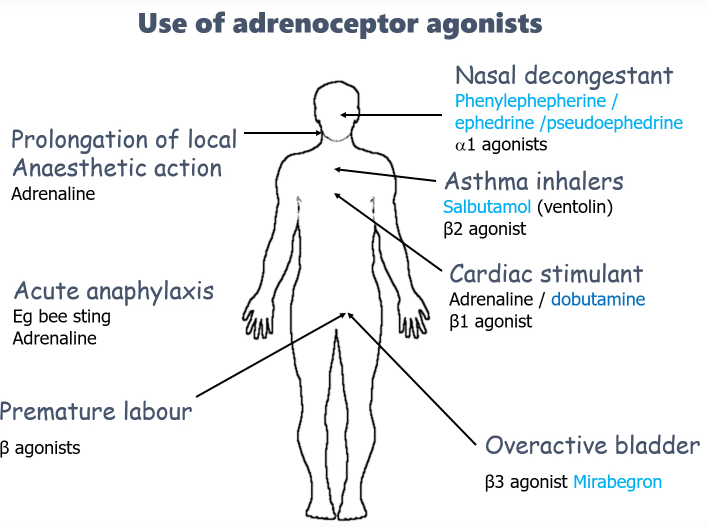
-
Overall summary of the Uses of Adrenoceptor Blockers
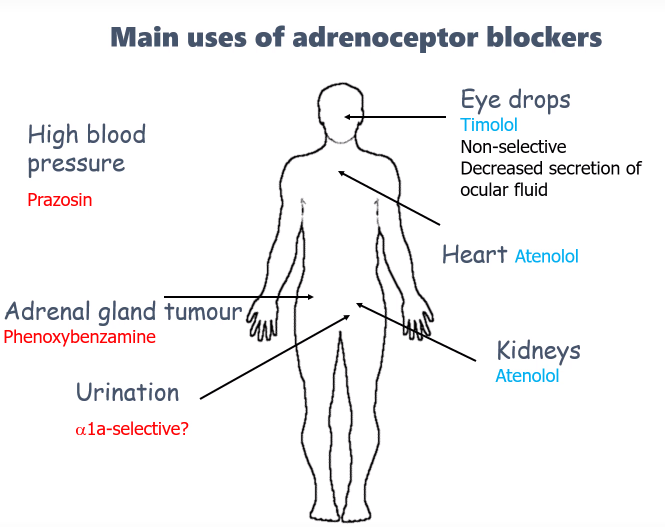
-
Altering endogenous noradrenaline Summary
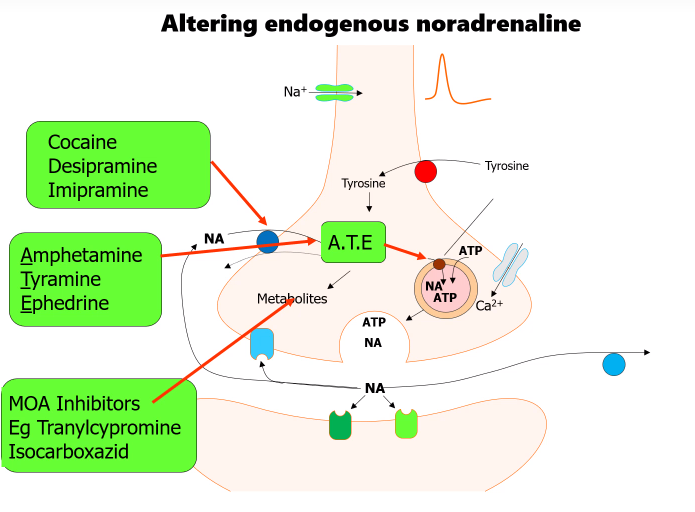
-
What happens to noradrenaline after its targeted receptors have been inhibited by drugs?
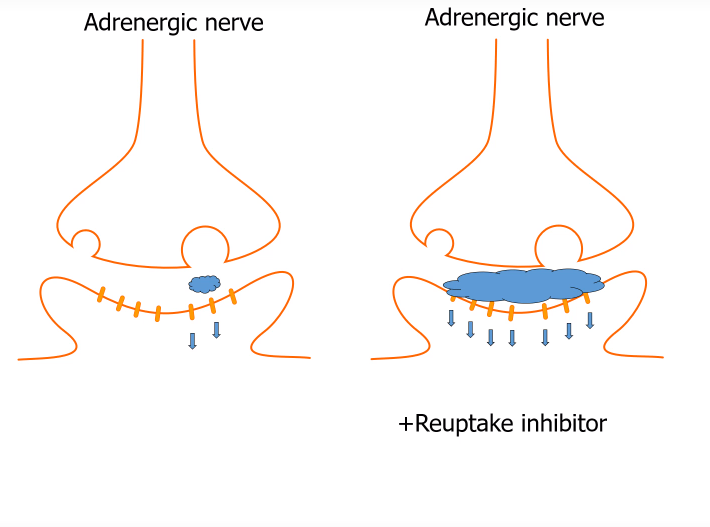
Some of these drugs inhibit receptors (block), as a result noradrenaline is built up in the synaptic cleft
-
What are some Clinical uses of Reuptake inhibitors?
-Depression
-ADD (Attention deficit disorder)
-
What are some Clinical uses of Enzyme inhibitors on Monoamine oxidase?
-Depression
-
Acetylcholine: Antagonist and Agonist Drugs Summary
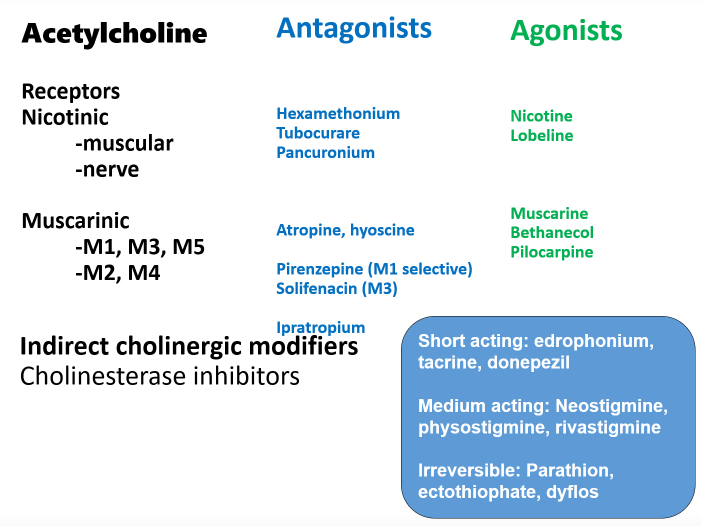
-
Are drugs like ATROPINE and HYOSCINE muscarinic blockers?
Yes
-
What are some Clinical Uses of muscarinic blockers? (e.g. ATROPINE or HYOSCINE)
-Premedication before anaesthesia to reduce secretions, sedation, prevent vagal effects
-In heart block to increase AV conduction
-Ophthalmology to produce mydriasis (dilation of pupil) for examination
-Bronchodilation in severe airways disease (IPRATROPIUM due to poor liquid solubility)
-Anti-spasmodic in GI colic
-Antacid-PIRENZIPINE-m1 selective
-Urinary incontinence-SOLIFENACIN-m3 selective
-
What are some Clinical uses of cholinoceptor agonist drugs?
Muscarinic agonists:
-PILOCARPINE (mAchR agonist) is used to treat glaucoma and dry mouth
-Used in sweat tests
-BETHANECHOL (maAchR agonist) occasionally used to aid bladder/gastric emptying
-
What are some Clinical uses of cholinesterase blockers
Agents such as TACRINE, DONEPEZIL or RIVASTIGMINE used in:
-dementia
-Neuromuscular disease such as MYASTHESIA GRAVIS or EATON-LAMBERT syndrome
^ All work by raising the level of endogenous acetylcholine
-
Examples of how you would treat specific problems by modulation of the ANS:
